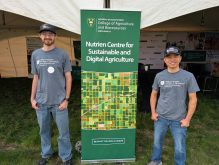A western Canadian crop tour organized by CWB is generating interest beyond Canada’s borders.
The tour has also sparked interest among analysts and market research groups in China and the United States.
Arnella Trent, a crop assessment analyst with the U.S. Department of Agriculture, was one of the foreign experts who signed up to participate in this year’s tour.
“I am trying to do some ground-truthing to see how the crops are actually progressing,” said Trent, whose office is based in Washington, D.C.
Read Also

Agi3’s AI-powered individualized farm insurance products win innovation prize
Agi3’s AI-powered individualized farm insurance products won the business solutions prize in the Innovations Program Awards prior to the Agriculture in Motion farm show in Langham, Saskatchewan.
“There is quite a bit of uncertainty in the United States in terms of whether the Canadian crop is way behind (in maturity) and whether that is going to affect yields.”
“There’s also flooding throughout Saskatchewan and Manitoba and the impact of that is something we’re interested in learning more about. My reason for being here this week is just to see how the crop is progressing … and what direction the crop is going.”
Trent’s assessment of western Canadian crop conditions will be one of the key factors considered when the USDA comes up with its official estimate of Canadian crop production for 2014.
So far, her analysis of crops in northwestern Saskatchewan and northeastern Alberta is mostly positive.
“Right now, at least in the areas that we’ve traveled through, things look pretty good. Yes, the crop is delayed in some areas, probably by a week or even two weeks in some areas … but if farmers can get through Aug. 15 without any problems, it could shape up to be a really good year.”
Trent’s approach to determining Canadian crop production is based on a variety of factors.
Her analysis starts early in the year by examining winter snowfall, runoff, stream flows and precipitation.
Statistics Canada’s annual report on Canadian seeding intentions serves as a baseline for her calculations.
As the spring seeding season begins, her analysis pays close attention to weather patterns, provincial crop reports and media sources.
Satellite imagery that assesses vegetation across Western Canada is also considered.
By early August, an estimate is prepared and presented to the USDA for debate and further consideration.
Trent will present her numbers for Canadian canola production next week in Washington.

















